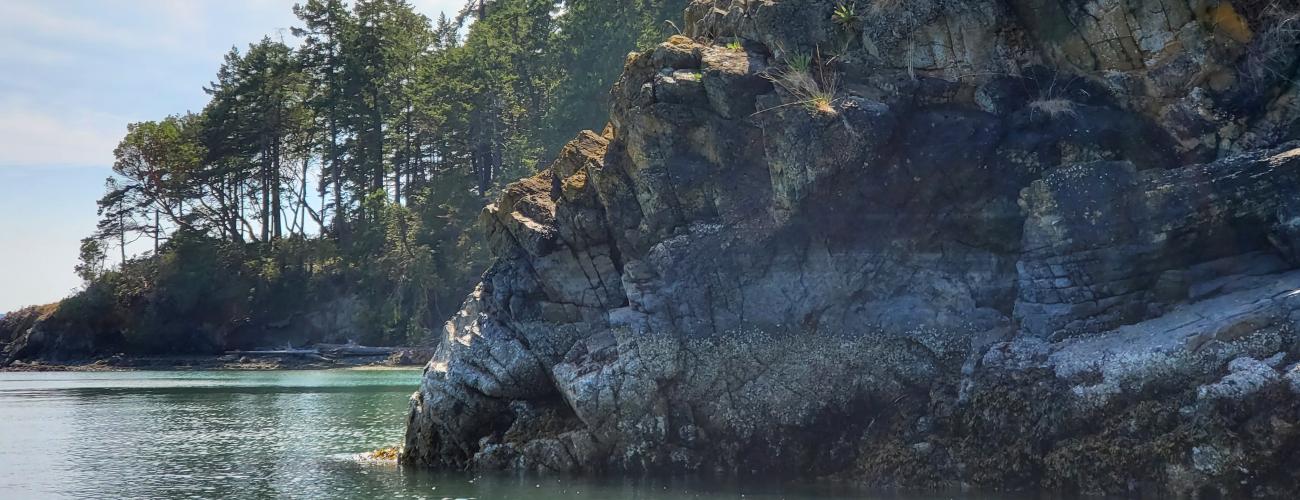Hope Island (Skagit) Marine State Park History
Hope Island State Park is one of two Washington state parks with the same name. This one is the more northerly one, located in Skagit County near Deception Pass.
Rock From Below Earth’s Crust
The bedrock that makes up Hope Island is serpentinite, a metamorphic rock formed at tectonic plate boundaries. It is formed from rock of Earth's mantle, the 1,800-mile-thick layer underneath our planet's crust. Serpentinite is created when the mineral olivine is heated and pressurized while simultaneously absorbing large amounts of water. The volume of the rock increases 30-40% and produces heat that powers hydrothermal vents on the sea floor above it. Hope Island’s serpentinite is part of a larger assemblage of rocks that outcrop on nearby islands and collectively make up an ophiolite sequence, a distinctive formation of rocks formed where the sea floor has spread apart at a tectonic plate boundary.
Indigenous Land
The park lies within the traditional territory of Coast Salish Indigenous people whose present-day descendants include members of the Samish Indian Nation, Swinomish Indian Tribal Community, Lummi Nation, and Tulalip Tribes. Local tribes ceded ownership of the area to the US federal government in the Treaty of Point Elliot in 1855, keeping rights to harvest natural resources in their usual and accustomed places, including the waters surrounding Hope Island.
Much of the land that makes up today’s Deception Pass, Skagit Island and Hope Island State Parks was established as a military reservation for the Department of the Army on September 22, 1866. Even though the lands held strategic significance, no military installations were ever built.
Becoming a State Park
When members of the State Parks Committee learned in October 1921 of a proposal to lease the Deception Pass military reservation to private individuals, they sent an urgent “night letter,” or overnight telegram, to U.S. Representative Lindley H. Hadley from Washington’s 2nd Congressional District suggesting that the “State Parks Committee would rather have the property turned over to them for care.”
On March 23, 1922, the U. S. Congress passed H.R. 9235, providing that:
…title and fee to all of the land comprising the military reservation…. [is] hereby granted…..to the State of Washington for public park purposes ….
The Washington State Parks Committee formally accepted the grant on April 17, 1922.
Natural Area Preserve
The island’s status as a US Military Reservation meant it was off-limits to settlement, logging and mining. When staff completed a Natural Forest Inventory in 1993, it was found to have old growth forests of Douglas fir up to 84 inches in diameter, western red cedar and western hemlock in good to excellent condition. The forest has a well-developed multi-layered canopy and many large, downed logs and snags. A band of drier forest above the island’s southern shoreline is co-dominated by Pacific madrone and Douglas fir, with some Pacific yew and Rocky Mountain juniper as well.
Recreational development on Hope Island has been limited to a small designated camping area on the northwest part of the island at Lang Cove, and a few primitive trails that radiate from the camp spot.
On June 11, 1999, the WSPRC approved the designation of 176 acres of the park as a Natural Area Preserve, defined as an area with a principal function “to preserve natural ecosystems or geologic features of statewide significance.”
Sharing the histories of Washington’s state parks is an ongoing project. Learn more here.

